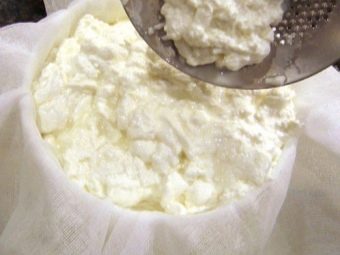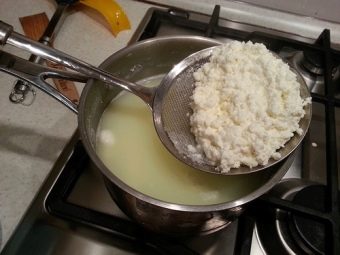Calcined cottage cheese: the benefits and harm, homemade recipes

From early childhood we are told about the benefits of cottage cheese, as the main source of calcium. But it turns out that the amount of calcium in the product can be increased.How to do it, and most importantly - for what purpose, will be discussed in the article.
What it is?
Calcined cottage cheese got its name to the high content of calcium in the composition. The latter is a necessary component for growth and development, provides increased bone strength, ensures the health of teeth and hair.
Calcium is known to be present in all fermented milk products, but cottage cheese is the champion for its content. However, in some cases, calcium is not enough, and resort to additional enrichment of the product with this element. Calcium is added to the curd in the form of pharmaceutical preparations such as calcium chloride or powdered calcium lactate.
It is important to respect the proportions of such additives, because with their excess, instead of benefit, you can harm the body. A large number of them leads to bitterness in the taste of the product. Excessive intake of calcium in the body can also be avoided by moderate intake of calcined “sour milk” - two or three times a week will be enough.
It should be noted that the name "cottage cheese" to apply to this product is not entirely correct. Cottage cheese is prepared by souring whole milk with fermented milk sourdough; animal fats are an essential component.
The calcined product is prepared in milk, which is rolled (skachivaet) by adding potassium chloride. As a result, the content of calcium in it increases - it is already contained in dairy products, and additionally entered along with the additive. In addition, the presence of calcium chloride increases the release of protein, so the product also has an increased protein content. Milk sugars, phosphorus, magnesium and iron are also present in the composition of the calcined cheesy product.
What is useful?
Cottage cheese with the addition of calcium chloride is an easily digestible product that can be attributed to diet food. It is essential for the formation of the skeleton, as well as growth and development. Deficiency of elements in the period of active growth can lead to skeletal deformation, physical deformities, and disability.
No less important is this element for older people. Calcium at this time is more actively washed out of the body, which leads to an increased risk of bone fractures. At the same time, given the lack of calcium, the bones after fractures grow together poorly. A person faces immobility and even disability.
The calcined version of this fermented milk product is very useful for toddlers, especially children from 1-4 years old, as well as to a child under one year old, adolescents and the elderly. During the period of childbearing and lactation, the mother's body actively loses calcium. It is not surprising that the cottage cheese enriched with this element is also useful to these individuals.
A number of diseases, including anemia, atherosclerosis, kidney disease, provoke calcium deficiency in the body, so if you have such a diagnosis, cottage cheese with calcium chloride will also be useful.
It is logical that its regular use will be one of the preventive measures to prevent these diseases.
During the recovery period after fractures, the body also needs a loading dose of calcium. Provide it will allow enriched curd.
In addition to the formation of the skeletal system, calcium is necessary for the process of blood formation. Its deficiency adversely affects the state of the nervous system, the body's ability to produce enzymes. Along with antioxidants, calcium helps slow the age-related changes of cells.
Since the product does not contain a large amount of animal fat, like natural cottage cheese, it is recommended for people suffering from obesity. A less fatty calcined product based on milk or kefir requires fewer enzymes for absorption, and therefore should be included in its menu because it suffers from insufficient fermentation, has digestive problems, suffers from indigestion.
Possible harm
Calcined cottage cheese will be harmful if you are hypersensitive to milk and dairy products. With an excess of this element in the body may cause nausea and vomiting, cramps at night, headaches.
An excess of calcium is no less dangerous than its deficiency. At the same time hypercalcemia develops, which entails such troubles as osteochondrosis, curvature of the radial bones. With an elevated calcium content, a number of other vital minerals (zinc, magnesium, phosphorus, copper) are hardly absorbed.
In this regard, it is very important not to include the calcined "sour milk" in the diet on an ongoing basis. You should also consider the calcium content in vitamins and dietary supplements, if you take them. Especially taking calcium in the form of solutions and tablets with regular use of the calcined product should not be.
You can not get involved in calcined product during pregnancy, as this can lead to ossification of the fetal skull. As you know, at the time of birth and up to 3-4 months, these bones are mobile, otherwise it would be impossible for the child to pass through the birth canal.
The product also contains a large amount of protein, so it should be used with caution by people suffering from kidney disease. Excess protein can cause abdominal pain and intestinal colic, constipation.
Cooking at home
Preparing a healing product is quite simple. The first recipe involves the use of milk. It is better to use fresh (unpasteurized) cow or goat, however, if the product is prepared for a child, you should take a pasteurized counterpart. Fresh will be too fat for baby intestines.
Calcium chloride will be used as an additive. For half a liter of milk will need a tablespoon of the drug. Milk needs to be heated to + 40C, after which calcium is added and the composition is brought to a boil, not allowing it to boil.
At the bottom of the sieve you need to lay a clean layer of gauze in 2 layers and fold the mixture. When whey is drained, there will be a calcined curd in the pot. You can speed up the process of its preparation by putting the curd in a sieve under oppression.
If the result is too dry mass, you can add a little milk or sour cream to it before use.
If it is not possible to find ampoules with calcium chloride, then it is possible to prepare calcium cottage cheese with calcium lactate at home. The latter is available in the form of tablets and powder. If you bought the pills, they must first be ground to a powder.
For 1 l of milk you will need 10 pounded tablets of lactate. The technology of preparation is almost the same as described above. First, the milk is heated, then calcium is poured. After this, it is necessary to hold the mixture for a little more time on the fire, after waiting for it to be folded, and then fold it back onto a sieve.
After waiting for the whey to drain, you can begin tasting the healthy curd. By the way, the serum does not need to be poured, because by the content of calcium it overtakes even the resulting product. On its basis, you can prepare drinks or flavor it with cottage cheese.
The production of enriched curd can be conducted on a milk-kefir basis. To do this, mix the yogurt and milk, taken in a volume of 1 liter. Heat the composition without stirring, after which two 10 ml ampoules of calcium chloride solution 10% should be introduced into it. This will be approximately 2 tablespoons.
As soon as the product starts to turn off, not allowing it to boil, it is removed from the fire. It remains only to let the excess fluid to drain.
If you decide to cook cottage cheese on one of the above recipes, it is important to respect the proposed dosage of pharmaceutical preparations. Changing the volume of milk, make sure that the amount of injected calcium and kefir changes accordingly (if the product is prepared from milk and a fermented milk drink).
Store the finished product in the refrigerator for no more than two days. It is better to use it immediately after preparation, there is no point in preparing for future use.The daily dosage for an adult should not exceed 100 g. The children's norm ranges from 10 to 70 g, depending on the age of the child.
If the baby does not want to take the product, you can “disguise” it in kefir, yogurt, flavor it with berries and fruits.
Tips
Despite the fact that the cottage cheese is easily digested, it is better to introduce it into the child's diet not earlier than 6 months. As with the introduction of any complementary foods, it is not necessary to begin to include the product in the child’s diet during illness, after vaccinations or in extreme heat.
As Dr. Komarovsky, who is respected by modern mothers, says, even the most useful product that a child is forced to eat will bring some benefit. It is important that the child eats the cottage cheese with pleasure, it is not necessary to feed him with force.
Starting to enter the curd should be with a small dose (at the tip of a teaspoon), gradually increasing the amount of the product to 2-3 tablespoons by the year. When a rash and other negative reactions occur, you should stop giving the curd. After a while, you can try to return to it, after reducing the dosage and frequency of consumption.
You will learn the recipe for calcined cottage cheese from the following video.
































